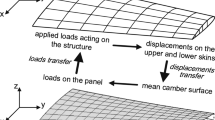Conclusion
The purpose of the last three sections is to demonstrate by representative examples that control theory can be used to formulate computationally feasible procedures for aerodynamic design. The cost of each iteration is of the same order as two flow solutions, since the adjoint equation is of comparable complexity to the flow equation, and the remaining auxiliary equations could be solved quite inexpensively. Provided, therefore, that one can afford the cost of a moderate number of flow solutions, procedures of this type can be used to derive improved designs. The approach is quite general, not limited to particular choices of the coordinate transformation or cost function, which might in fact contain measures of other criteria of performance such as lift and drag. For the sake of simplicity certain complicating factors, such as the need to include a special term in the mapping function to generate a corner at the trailing edge, have been suppressed from the present analysis. Also it remains to explore the numerical implementation of the design procedures proposed in this paper.
Similar content being viewed by others
References
Bristeau, M. O., Pironneau, O., Glowinski, R., Periaux, J., Perrier, P., and Poirier, G. (1985). On the numerical solution of nonlinear problems in fluid dynamics by least squares and finite element methods (II). Application to transonic flow simulations,Proc. 3rd International Conference on Finite Elements in Nonlinear Mechanics, FENOMECH 84, Stuttgart, 1984, J. St. Doltsinis, (ed.), North-Holland, Amsterdam, pp. 363–394.
Garabedian, P. R. and Korn, D. G. (1971). “Numerical Design of Transonic Airfoils”, Proc. SYNSPADE 1970, Hubbard, B., ed., Academic Press, New York, 1971, pp. 253–271.
Garabedian, P., and McFadden, G. (1982). Computational fluid dynamics of airfoils and wings,Proc. of Symposium on Transonic, Shock, and Multidimensional Flows, Madison, 1981, R. Meyer (ed.), Academic Press, New York, pp. 1–16.
Giles, M., Drela, M. and Thompkins, W. T. (1985). “Newton Solution of Direct and Inverse Transonic Euler Equations”, AIAA Paper 85-1530, Proc. AIAA 7th Computational Fluid Dynamics Conference, Cincinnati, 1985, pp. 394–402.
Henne, P. A. (1980). An inverse transonic wing design method, AIAA Paper No. 80-0330.
Hicks, R. M. and Henne, P. A. (1979). “Wing Design by Numerical Optimization”, AIAA Paper 79-0080, 1979.
Jameson, A. (1974). Iterative solution of transonic flows over airfoils and wings, including flows at Mach 1,Commun. Pure Appl. Math. 27, 283–309.
Jameson, A. (1987). Successes and challenges in computational aerodynamics, AIAA Paper No. 87-1184-CP, 8th Computational Fluid Dynamics Conference, Hawaii.
Jameson, A., and Caughey, D. A. (1977). A finite volume method for transonic potential flow calculations, Proc. AIAA 3rd Computational Fluid Dynamics Conference, Albuquerque, pp. 35–54.
Jameson, A., Schmidt, W., and Turkel, E. (1981). Numerical solution of the Euler equations by finite volume methods using Runge-Kutta time stepping schemes, AIAA Paper No. 81-1259, AIAA 14th Fluid Dynamics and Plasma Dynamics Conference, Palo, Alto, California.
Jameson, A., Baker, T. J., and Weatherill, N. P. (1986). Calculation of inviscid transonic flow over a complete aircraft, AIAA Paper No. 86-0103, AIAA 24th Aerospace Sciences Meeting, Reno, Nevaca.
Lighthill, M. J. (1945). A new method of two-dimensional aerodynamic design, ARC, Rand M 2112.
Lions, J. L. (1971). “Optimal Control of Systems Governed by Partial Differential Equations”, translated by S. K. Mitter, Springer Verlag, New York, 1971.
MacCormack, R. W. (1985). Current status of numerical solutions of the Navier-Stokes equations, AIAA Paper No. 85-0032, AIAA 23rd Aerospace Sciences Meeting, Reno, Nevada.
McFadden, G. B. (1979). An artificial viscosity method for the design of supercritical airfoils, New York University report No. C00-3077-158.
Murman, E. M., and Cole, J. D. (1971). Calculation of plane steady transonic flows,AIAA J. 9, 114–121.
Ni, R. H. (1982). A multiple grid scheme for solving the Euler equations,AIAA J. 20, 1565–1571.
Pulliam, T. H., and Steger, J. L. (1985). Recent improvements in efficiency, accuracy and convergence for implicit approximate factorization algorithms, AIAA Paper No. 85-0360, AIAA 23rd Aerospace Sciences Meeting, Reno, Nevada.
Taverna, F. (1983). Advanced airfoil design for general aviation propellers, AIAA Paper No. 83-1791.
Tranen, J. L. (1974). A rapid computer aided transonic airfoil design method, AIAA Paper No. 74-501.
Volpe, G., and Melnik, R. E. (1986). The design of transonic aerofoils by a well posed inverse method,Int. J. Numer. Methods Eng.,22, 341–361.
Author information
Authors and Affiliations
Rights and permissions
About this article
Cite this article
Jameson, A. Aerodynamic design via control theory. J Sci Comput 3, 233–260 (1988). https://doi.org/10.1007/BF01061285
Received:
Issue Date:
DOI: https://doi.org/10.1007/BF01061285




